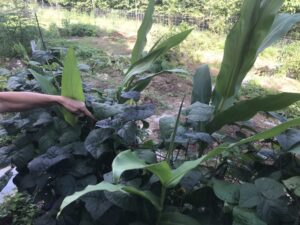- Like
- Digg
- Del
- Tumblr
- VKontakte
- Buffer
- Love This
- Odnoklassniki
- Meneame
- Blogger
- Amazon
- Yahoo Mail
- Gmail
- AOL
- Newsvine
- HackerNews
- Evernote
- MySpace
- Mail.ru
- Viadeo
- Line
- Comments
- Yummly
- SMS
- Viber
- Telegram
- Subscribe
- Skype
- Facebook Messenger
- Kakao
- LiveJournal
- Yammer
- Edgar
- Fintel
- Mix
- Instapaper
- Copy Link
A version of this column first ran in the Roane County (WV) Reporter and Times Record as part of a gardening series. Support local journalism! Subscribe to your local newspaper. This is one of a series of blogs for new gardeners. Start reading the whole series here: Part 1.
You’ve put up a good fence around your garden, good enough to ensure that deer can’t get in, groundhogs and rabbits can’t get in, the neighbors’ cats and dogs can’t get in…and now there’s a scientist in your garden? Oh, wait—the scientist is you.
Every serious gardener will want to research garden questions sooner or later. This column is about doing it right. I’ve mentioned this before—about not relying on memory– but now I’m going to go in deeper and give examples.
What I mean by doing it right comes down to two things: setting up your test in such a way as to eliminate—or minimize—confounding variables, and recording your parameters so you don’t find when the experiment is over that you don’t know what you learned because you relied on your memory and now you aren’t sure which was which.
Examples of questions you might want to research: which of these tomatoes do I think tastes best? Which kind of lettuce stays sweet longest and bolts last? Which works better for onions—deeply worked soil or soil that has barely been turned over? Does compost really help tomatoes resist disease? Would leaf mold work better than compost for carrots?
The first two questions are very simple—you just need to mark the names of the varieties either on a garden map, or on markers of some sort right next to the rows or plants. If you happen to find a set of old, discarded venetian blinds, they make great labels. You cut each one into three or four pieces, and write on them with an indelible pen. I have been using one I bought from Pinetree Seeds years ago, a marker intended to withstand sun and rain. They’re currently selling it for $2.49.
If the question is about soil treatment, you can do things differently on different ends of a bed. But to be really rigorous about it, you’d need to make your test plots more complex; what if the soil is different at different ends of your bed? About 15 years ago I saw how the researchers at the Organic Farm at WVU in Morgantown got around this possibility. They wanted to see whether adding compost around the base of tomatoes would protect against a certain disease. (I knew about this because I shared a house with one of the researchers, and I got to collect a lot of the tomatoes.) So they set up a plot with numbered rows, and numbered the plants within each row, then they scattered the test plants randomly through the bed—half had compost set around them, half didn’t—and recorded the locations of the test plants. By the time of harvest they no longer could tell or remember which plants were which. Then they had to separately weigh and record the harvest from each plant, to see whether they got more tomatoes from the treated plants. That study was a bust, because the disease in question never showed up that year. But it worked very well for me—I got enough tomatoes to can in a year when I didn’t have a garden.
I also learned something about study procedures. With that random mix of test and control plants, it wouldn’t matter if one end of the field had richer soil or more moisture than another. For most of us, that’s a bit too much trouble to go to—we aren’t looking for peer review, we just want to decide which kind of bean stays tender longest, or whether covering cabbages with row cover or tulle actually results in better produce, or what variety of kale is hardiest (sure enough, the Vates kale that Southern Exposure Seed Exchange claimed was the hardiest did survive the last winter, without a cover…but so did the Red Russian kale. More study needed).
I am using a simplified version to test the question of working the soil well for onions, versus just shoving the onion sets into ground I worked in fall but only ripped the vetch off of this spring. The southeast and northwest quadrants were worked and the other two were not. I figure that’s a good enough test procedure for the home gardener.
Read the rest: Part 1. Part 2. Part 3. Part 4. Part 5. Part 6. Part 7. Part 8. Part 9. Part 10. Part 11. Part 12. Part 13. Part 14. Part 15. Part 16. Part 17. Part 18. Part 19. Part 20. Part 21. Part 22. Part 23. Part 24. Part 25. Part 26. Part 27. Part 28. Part 29. Part 30. Part 31. Part 32. Part 33. Part 34. Part 35. Part 36. Part 37. Part 38. Part 39. Part 40. Part 41. Part 42. Part 43. Part 44. Part 45. Part 46. Part 47. Part 48. Part 49. Part 50.













